Impact of Lifestyle Changes on Blood Pressure Control in Hypertensive Patients
VerifiedAdded on 2023/03/23
|13
|3068
|23
AI Summary
This article explores the impact of lifestyle changes on blood pressure control in hypertensive patients. It discusses the effectiveness of lifestyle changes compared to pharmacological intervention. The study analyzes the relationship between lifestyle modifications and blood pressure control, highlighting factors such as weight gain, physical inactivity, and salt intake. The article also discusses the implications for nursing practice and potential barriers to implementing lifestyle interventions. Overall, it provides valuable insights into managing hypertension through lifestyle changes.
Contribute Materials
Your contribution can guide someone’s learning journey. Share your
documents today.
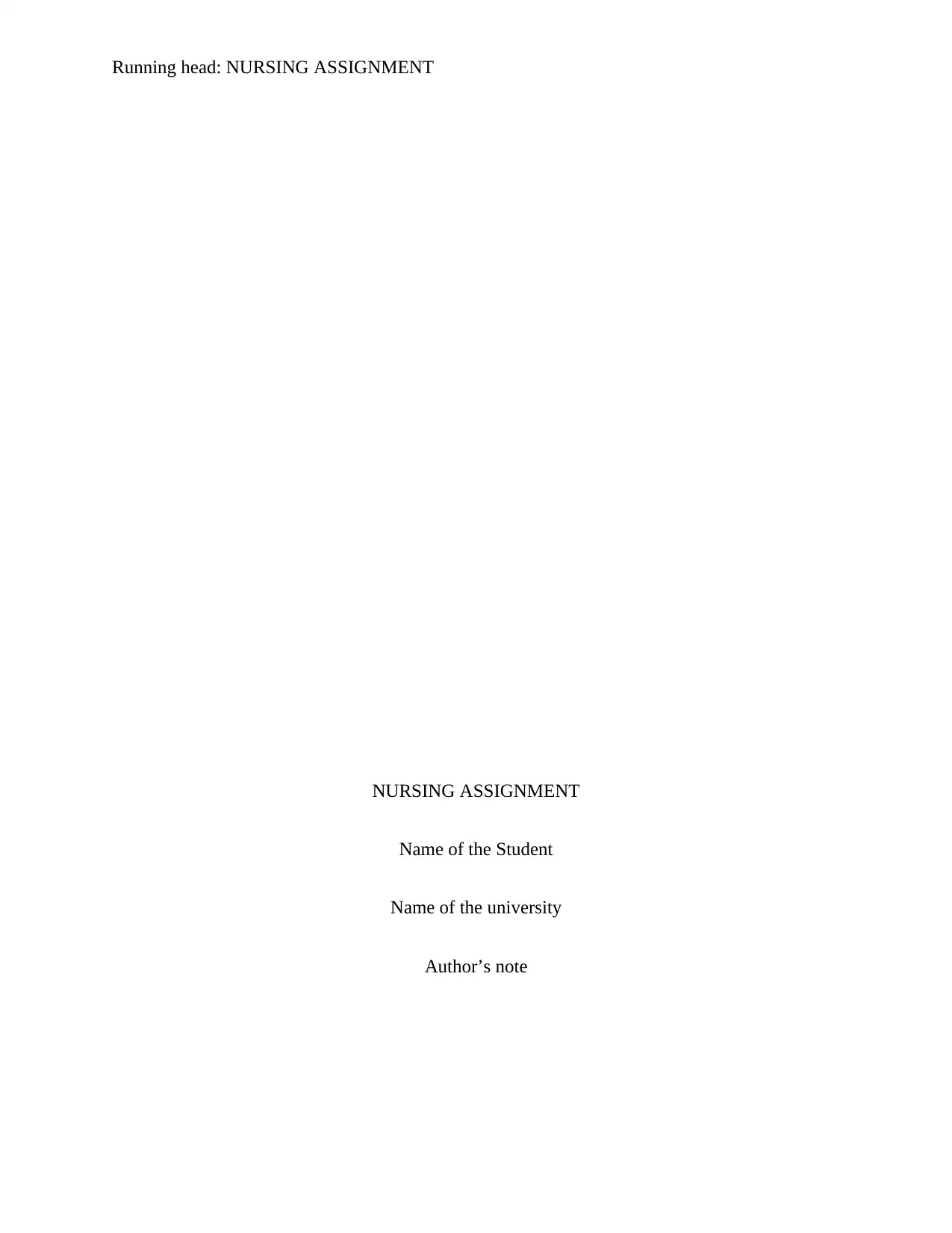
Running head: NURSING ASSIGNMENT
NURSING ASSIGNMENT
Name of the Student
Name of the university
Author’s note
NURSING ASSIGNMENT
Name of the Student
Name of the university
Author’s note
Secure Best Marks with AI Grader
Need help grading? Try our AI Grader for instant feedback on your assignments.
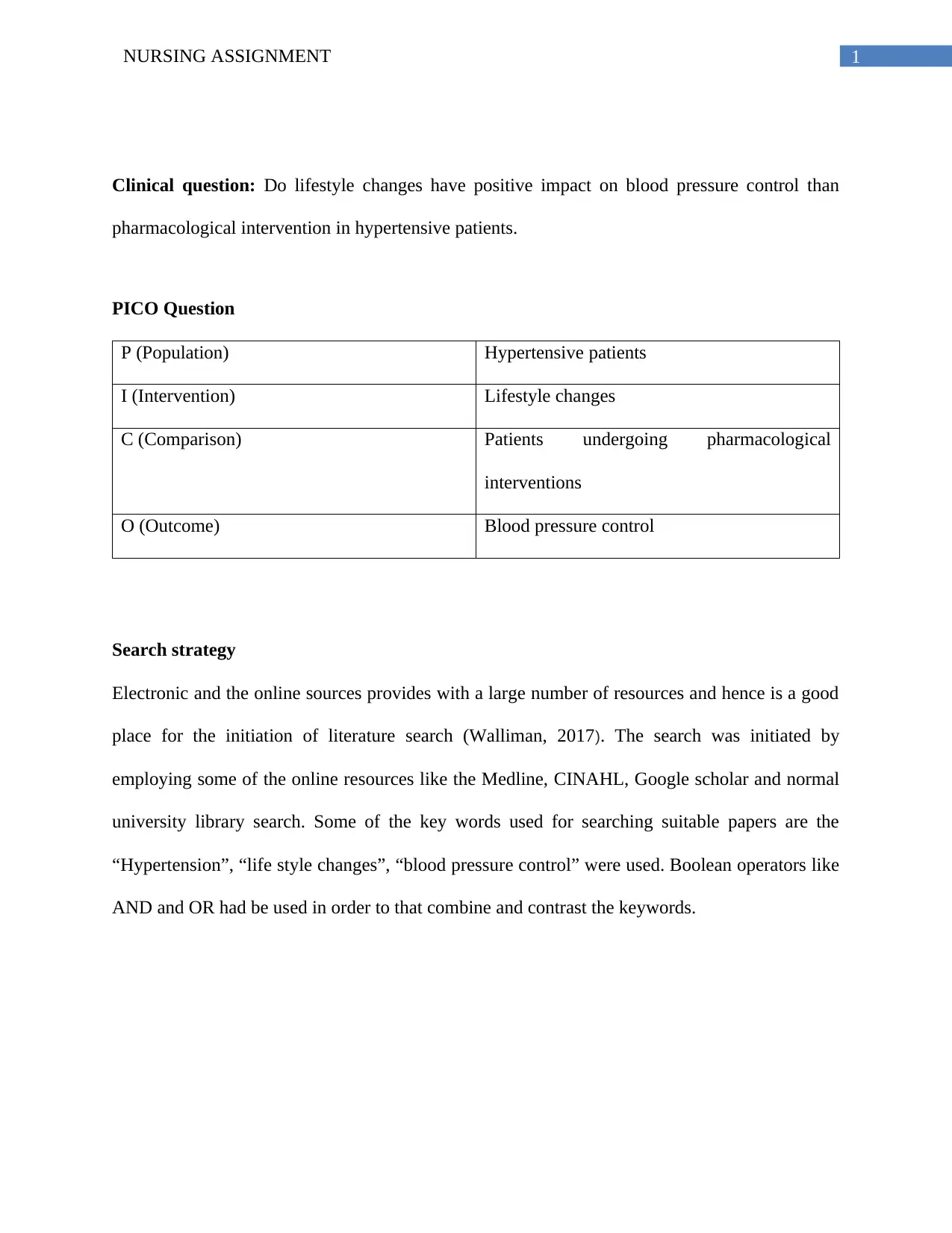
1NURSING ASSIGNMENT
Clinical question: Do lifestyle changes have positive impact on blood pressure control than
pharmacological intervention in hypertensive patients.
PICO Question
P (Population) Hypertensive patients
I (Intervention) Lifestyle changes
C (Comparison) Patients undergoing pharmacological
interventions
O (Outcome) Blood pressure control
Search strategy
Electronic and the online sources provides with a large number of resources and hence is a good
place for the initiation of literature search (Walliman, 2017). The search was initiated by
employing some of the online resources like the Medline, CINAHL, Google scholar and normal
university library search. Some of the key words used for searching suitable papers are the
“Hypertension”, “life style changes”, “blood pressure control” were used. Boolean operators like
AND and OR had be used in order to that combine and contrast the keywords.
Clinical question: Do lifestyle changes have positive impact on blood pressure control than
pharmacological intervention in hypertensive patients.
PICO Question
P (Population) Hypertensive patients
I (Intervention) Lifestyle changes
C (Comparison) Patients undergoing pharmacological
interventions
O (Outcome) Blood pressure control
Search strategy
Electronic and the online sources provides with a large number of resources and hence is a good
place for the initiation of literature search (Walliman, 2017). The search was initiated by
employing some of the online resources like the Medline, CINAHL, Google scholar and normal
university library search. Some of the key words used for searching suitable papers are the
“Hypertension”, “life style changes”, “blood pressure control” were used. Boolean operators like
AND and OR had be used in order to that combine and contrast the keywords.
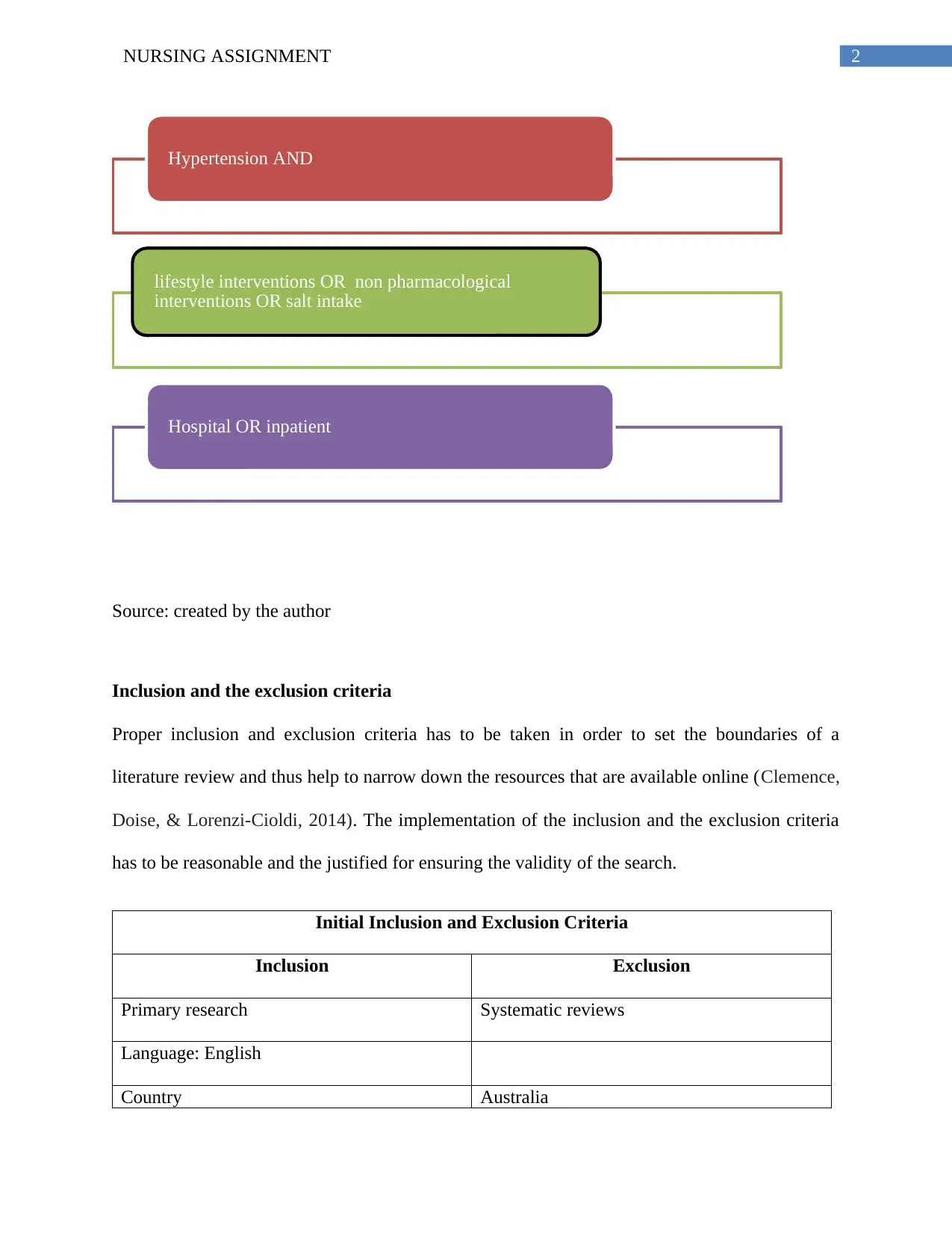
2NURSING ASSIGNMENT
Source: created by the author
Inclusion and the exclusion criteria
Proper inclusion and exclusion criteria has to be taken in order to set the boundaries of a
literature review and thus help to narrow down the resources that are available online (Clemence,
Doise, & Lorenzi-Cioldi, 2014). The implementation of the inclusion and the exclusion criteria
has to be reasonable and the justified for ensuring the validity of the search.
Initial Inclusion and Exclusion Criteria
Inclusion Exclusion
Primary research Systematic reviews
Language: English
Country Australia
Hypertension AND
lifestyle interventions OR non pharmacological
interventions OR salt intake
Hospital OR inpatient
Source: created by the author
Inclusion and the exclusion criteria
Proper inclusion and exclusion criteria has to be taken in order to set the boundaries of a
literature review and thus help to narrow down the resources that are available online (Clemence,
Doise, & Lorenzi-Cioldi, 2014). The implementation of the inclusion and the exclusion criteria
has to be reasonable and the justified for ensuring the validity of the search.
Initial Inclusion and Exclusion Criteria
Inclusion Exclusion
Primary research Systematic reviews
Language: English
Country Australia
Hypertension AND
lifestyle interventions OR non pharmacological
interventions OR salt intake
Hospital OR inpatient
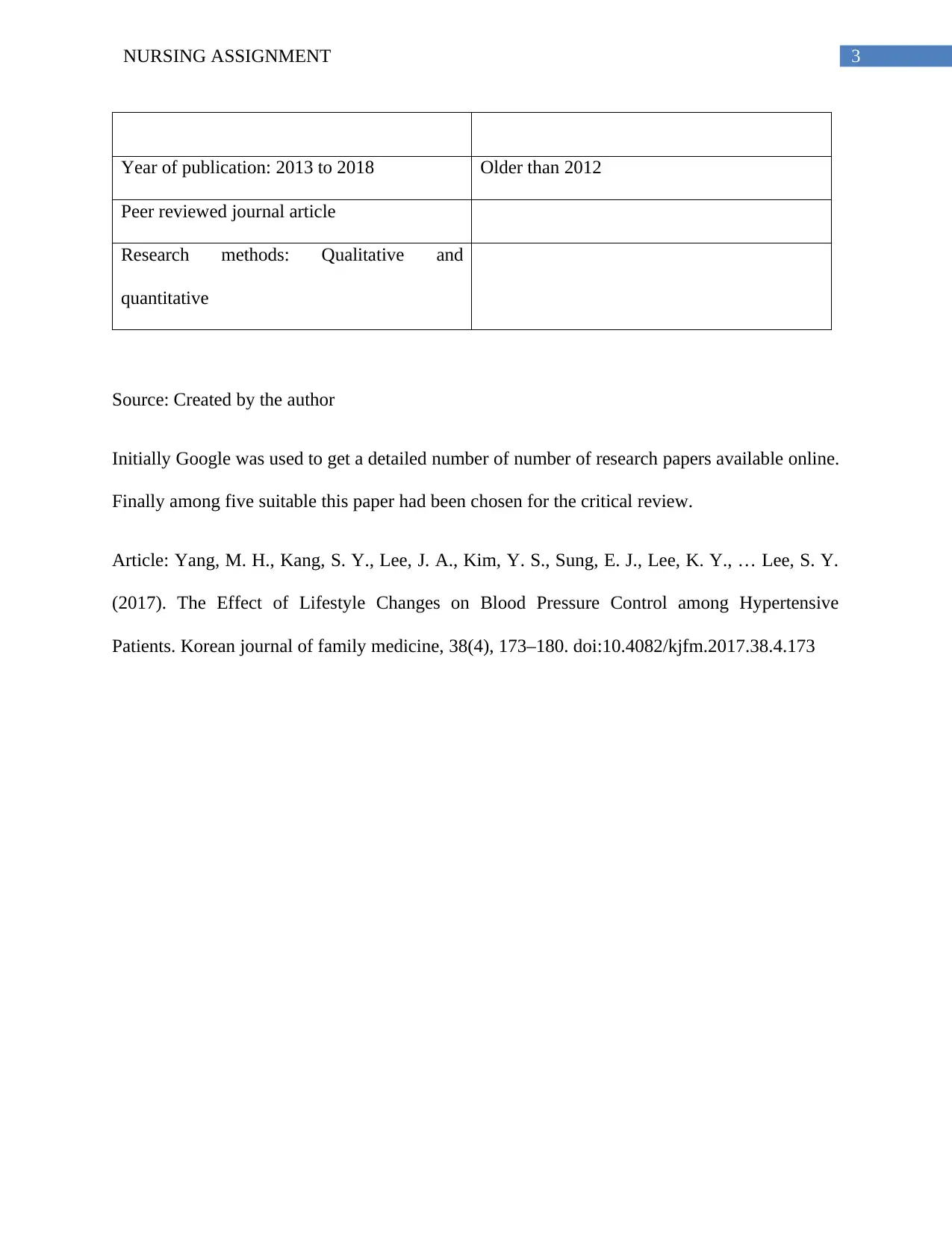
3NURSING ASSIGNMENT
Year of publication: 2013 to 2018 Older than 2012
Peer reviewed journal article
Research methods: Qualitative and
quantitative
Source: Created by the author
Initially Google was used to get a detailed number of number of research papers available online.
Finally among five suitable this paper had been chosen for the critical review.
Article: Yang, M. H., Kang, S. Y., Lee, J. A., Kim, Y. S., Sung, E. J., Lee, K. Y., … Lee, S. Y.
(2017). The Effect of Lifestyle Changes on Blood Pressure Control among Hypertensive
Patients. Korean journal of family medicine, 38(4), 173–180. doi:10.4082/kjfm.2017.38.4.173
Year of publication: 2013 to 2018 Older than 2012
Peer reviewed journal article
Research methods: Qualitative and
quantitative
Source: Created by the author
Initially Google was used to get a detailed number of number of research papers available online.
Finally among five suitable this paper had been chosen for the critical review.
Article: Yang, M. H., Kang, S. Y., Lee, J. A., Kim, Y. S., Sung, E. J., Lee, K. Y., … Lee, S. Y.
(2017). The Effect of Lifestyle Changes on Blood Pressure Control among Hypertensive
Patients. Korean journal of family medicine, 38(4), 173–180. doi:10.4082/kjfm.2017.38.4.173
Secure Best Marks with AI Grader
Need help grading? Try our AI Grader for instant feedback on your assignments.

4NURSING ASSIGNMENT
Abstract of the paper
Hypertension is a common clinical condition that is widely prevalent among patients
receiving care from primary care clinics. While several medicines are available over the counter
for controlling the blood pressure, various non-pharmacological interventions like using proper
diet or by maintaining proper lifestyle behaviors with effective blood pressure control. Hence
this paper aims to identify the factors and the lifestyle modifications associated with blood
pressure control among the patients who had been prescribed with an antihypertensive agent
(Jolles, Padwal, Clark & Braam, 2013).
A survey has been conducted at 15 hospitals in Korea from July 2008 to June 2010. 1453
patients, prescribed with canderstan, were recruited prospectively and were assessed. An initial
assessment of the lifestyle of the patient was done by using individual questions. Follow up
forms were given at 4, 8 and 12 weeks. Successful control of blood pressure was considered to
be 140 mm Hg systolic and <90 mm Hg diastolic.
Abstract of the paper
Hypertension is a common clinical condition that is widely prevalent among patients
receiving care from primary care clinics. While several medicines are available over the counter
for controlling the blood pressure, various non-pharmacological interventions like using proper
diet or by maintaining proper lifestyle behaviors with effective blood pressure control. Hence
this paper aims to identify the factors and the lifestyle modifications associated with blood
pressure control among the patients who had been prescribed with an antihypertensive agent
(Jolles, Padwal, Clark & Braam, 2013).
A survey has been conducted at 15 hospitals in Korea from July 2008 to June 2010. 1453
patients, prescribed with canderstan, were recruited prospectively and were assessed. An initial
assessment of the lifestyle of the patient was done by using individual questions. Follow up
forms were given at 4, 8 and 12 weeks. Successful control of blood pressure was considered to
be 140 mm Hg systolic and <90 mm Hg diastolic.
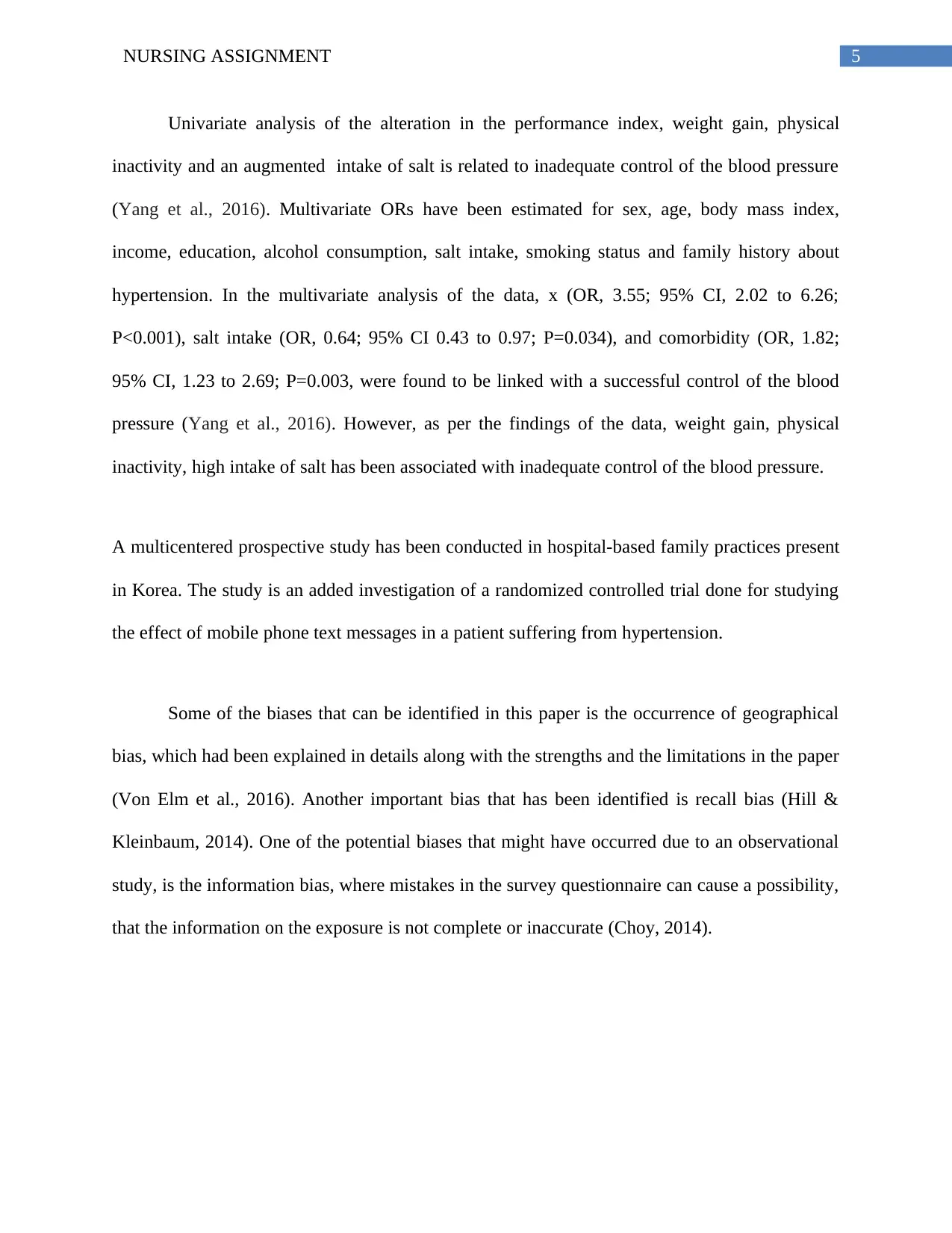
5NURSING ASSIGNMENT
Univariate analysis of the alteration in the performance index, weight gain, physical
inactivity and an augmented intake of salt is related to inadequate control of the blood pressure
(Yang et al., 2016). Multivariate ORs have been estimated for sex, age, body mass index,
income, education, alcohol consumption, salt intake, smoking status and family history about
hypertension. In the multivariate analysis of the data, x (OR, 3.55; 95% CI, 2.02 to 6.26;
P<0.001), salt intake (OR, 0.64; 95% CI 0.43 to 0.97; P=0.034), and comorbidity (OR, 1.82;
95% CI, 1.23 to 2.69; P=0.003, were found to be linked with a successful control of the blood
pressure (Yang et al., 2016). However, as per the findings of the data, weight gain, physical
inactivity, high intake of salt has been associated with inadequate control of the blood pressure.
A multicentered prospective study has been conducted in hospital-based family practices present
in Korea. The study is an added investigation of a randomized controlled trial done for studying
the effect of mobile phone text messages in a patient suffering from hypertension.
Some of the biases that can be identified in this paper is the occurrence of geographical
bias, which had been explained in details along with the strengths and the limitations in the paper
(Von Elm et al., 2016). Another important bias that has been identified is recall bias (Hill &
Kleinbaum, 2014). One of the potential biases that might have occurred due to an observational
study, is the information bias, where mistakes in the survey questionnaire can cause a possibility,
that the information on the exposure is not complete or inaccurate (Choy, 2014).
Univariate analysis of the alteration in the performance index, weight gain, physical
inactivity and an augmented intake of salt is related to inadequate control of the blood pressure
(Yang et al., 2016). Multivariate ORs have been estimated for sex, age, body mass index,
income, education, alcohol consumption, salt intake, smoking status and family history about
hypertension. In the multivariate analysis of the data, x (OR, 3.55; 95% CI, 2.02 to 6.26;
P<0.001), salt intake (OR, 0.64; 95% CI 0.43 to 0.97; P=0.034), and comorbidity (OR, 1.82;
95% CI, 1.23 to 2.69; P=0.003, were found to be linked with a successful control of the blood
pressure (Yang et al., 2016). However, as per the findings of the data, weight gain, physical
inactivity, high intake of salt has been associated with inadequate control of the blood pressure.
A multicentered prospective study has been conducted in hospital-based family practices present
in Korea. The study is an added investigation of a randomized controlled trial done for studying
the effect of mobile phone text messages in a patient suffering from hypertension.
Some of the biases that can be identified in this paper is the occurrence of geographical
bias, which had been explained in details along with the strengths and the limitations in the paper
(Von Elm et al., 2016). Another important bias that has been identified is recall bias (Hill &
Kleinbaum, 2014). One of the potential biases that might have occurred due to an observational
study, is the information bias, where mistakes in the survey questionnaire can cause a possibility,
that the information on the exposure is not complete or inaccurate (Choy, 2014).
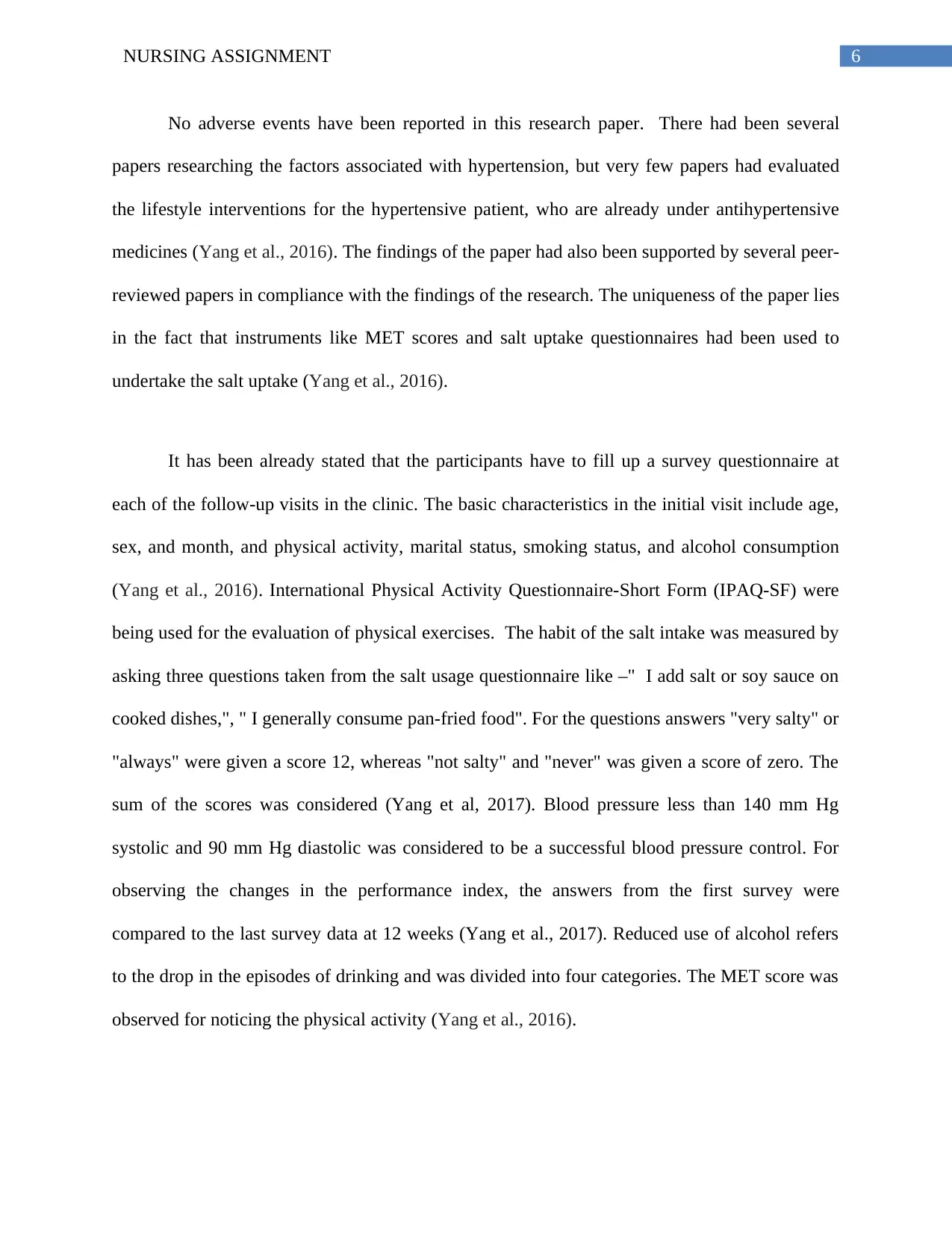
6NURSING ASSIGNMENT
No adverse events have been reported in this research paper. There had been several
papers researching the factors associated with hypertension, but very few papers had evaluated
the lifestyle interventions for the hypertensive patient, who are already under antihypertensive
medicines (Yang et al., 2016). The findings of the paper had also been supported by several peer-
reviewed papers in compliance with the findings of the research. The uniqueness of the paper lies
in the fact that instruments like MET scores and salt uptake questionnaires had been used to
undertake the salt uptake (Yang et al., 2016).
It has been already stated that the participants have to fill up a survey questionnaire at
each of the follow-up visits in the clinic. The basic characteristics in the initial visit include age,
sex, and month, and physical activity, marital status, smoking status, and alcohol consumption
(Yang et al., 2016). International Physical Activity Questionnaire-Short Form (IPAQ-SF) were
being used for the evaluation of physical exercises. The habit of the salt intake was measured by
asking three questions taken from the salt usage questionnaire like –" I add salt or soy sauce on
cooked dishes,", " I generally consume pan-fried food". For the questions answers "very salty" or
"always" were given a score 12, whereas "not salty" and "never" was given a score of zero. The
sum of the scores was considered (Yang et al, 2017). Blood pressure less than 140 mm Hg
systolic and 90 mm Hg diastolic was considered to be a successful blood pressure control. For
observing the changes in the performance index, the answers from the first survey were
compared to the last survey data at 12 weeks (Yang et al., 2017). Reduced use of alcohol refers
to the drop in the episodes of drinking and was divided into four categories. The MET score was
observed for noticing the physical activity (Yang et al., 2016).
No adverse events have been reported in this research paper. There had been several
papers researching the factors associated with hypertension, but very few papers had evaluated
the lifestyle interventions for the hypertensive patient, who are already under antihypertensive
medicines (Yang et al., 2016). The findings of the paper had also been supported by several peer-
reviewed papers in compliance with the findings of the research. The uniqueness of the paper lies
in the fact that instruments like MET scores and salt uptake questionnaires had been used to
undertake the salt uptake (Yang et al., 2016).
It has been already stated that the participants have to fill up a survey questionnaire at
each of the follow-up visits in the clinic. The basic characteristics in the initial visit include age,
sex, and month, and physical activity, marital status, smoking status, and alcohol consumption
(Yang et al., 2016). International Physical Activity Questionnaire-Short Form (IPAQ-SF) were
being used for the evaluation of physical exercises. The habit of the salt intake was measured by
asking three questions taken from the salt usage questionnaire like –" I add salt or soy sauce on
cooked dishes,", " I generally consume pan-fried food". For the questions answers "very salty" or
"always" were given a score 12, whereas "not salty" and "never" was given a score of zero. The
sum of the scores was considered (Yang et al, 2017). Blood pressure less than 140 mm Hg
systolic and 90 mm Hg diastolic was considered to be a successful blood pressure control. For
observing the changes in the performance index, the answers from the first survey were
compared to the last survey data at 12 weeks (Yang et al., 2017). Reduced use of alcohol refers
to the drop in the episodes of drinking and was divided into four categories. The MET score was
observed for noticing the physical activity (Yang et al., 2016).
Paraphrase This Document
Need a fresh take? Get an instant paraphrase of this document with our AI Paraphraser
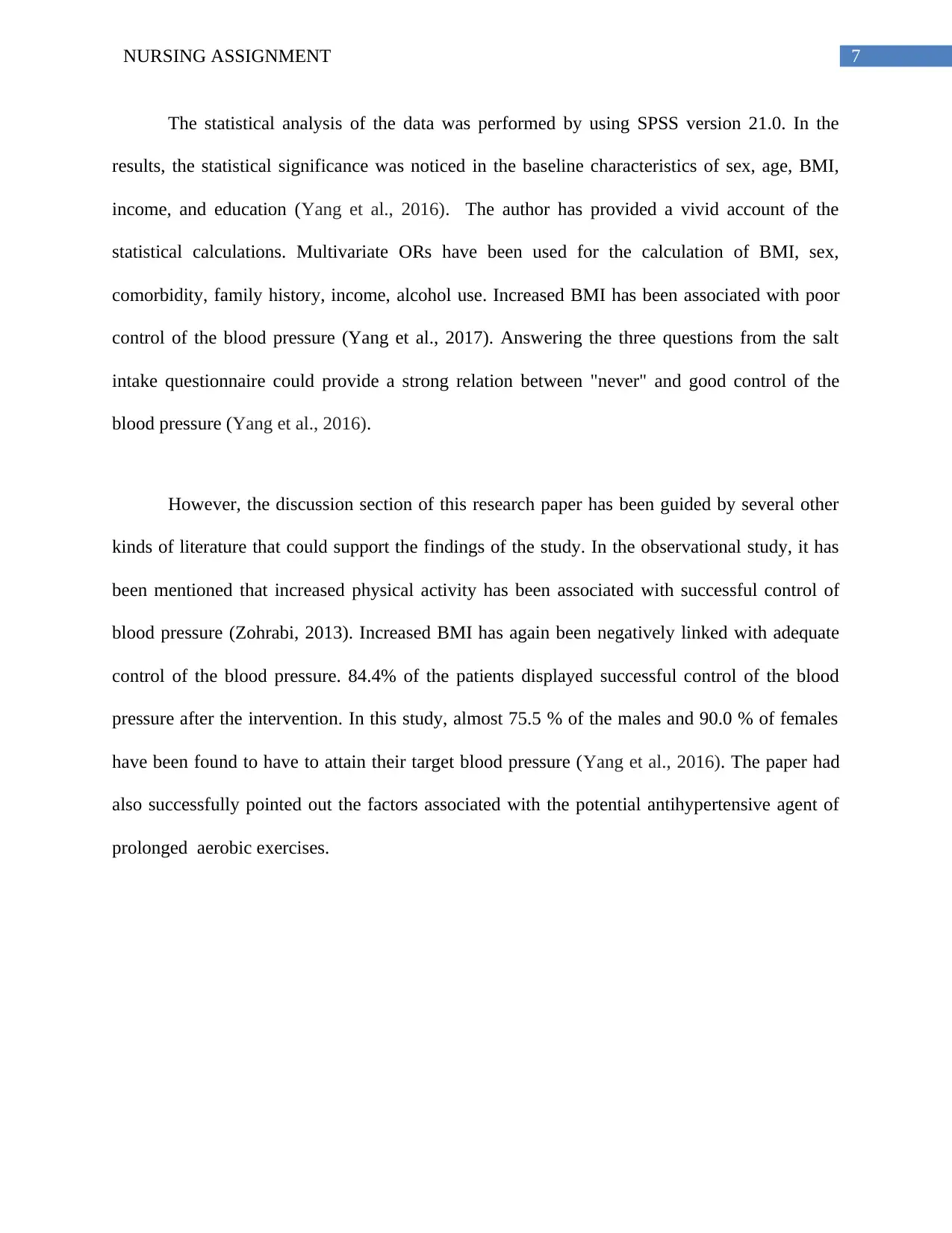
7NURSING ASSIGNMENT
The statistical analysis of the data was performed by using SPSS version 21.0. In the
results, the statistical significance was noticed in the baseline characteristics of sex, age, BMI,
income, and education (Yang et al., 2016). The author has provided a vivid account of the
statistical calculations. Multivariate ORs have been used for the calculation of BMI, sex,
comorbidity, family history, income, alcohol use. Increased BMI has been associated with poor
control of the blood pressure (Yang et al., 2017). Answering the three questions from the salt
intake questionnaire could provide a strong relation between "never" and good control of the
blood pressure (Yang et al., 2016).
However, the discussion section of this research paper has been guided by several other
kinds of literature that could support the findings of the study. In the observational study, it has
been mentioned that increased physical activity has been associated with successful control of
blood pressure (Zohrabi, 2013). Increased BMI has again been negatively linked with adequate
control of the blood pressure. 84.4% of the patients displayed successful control of the blood
pressure after the intervention. In this study, almost 75.5 % of the males and 90.0 % of females
have been found to have to attain their target blood pressure (Yang et al., 2016). The paper had
also successfully pointed out the factors associated with the potential antihypertensive agent of
prolonged aerobic exercises.
The statistical analysis of the data was performed by using SPSS version 21.0. In the
results, the statistical significance was noticed in the baseline characteristics of sex, age, BMI,
income, and education (Yang et al., 2016). The author has provided a vivid account of the
statistical calculations. Multivariate ORs have been used for the calculation of BMI, sex,
comorbidity, family history, income, alcohol use. Increased BMI has been associated with poor
control of the blood pressure (Yang et al., 2017). Answering the three questions from the salt
intake questionnaire could provide a strong relation between "never" and good control of the
blood pressure (Yang et al., 2016).
However, the discussion section of this research paper has been guided by several other
kinds of literature that could support the findings of the study. In the observational study, it has
been mentioned that increased physical activity has been associated with successful control of
blood pressure (Zohrabi, 2013). Increased BMI has again been negatively linked with adequate
control of the blood pressure. 84.4% of the patients displayed successful control of the blood
pressure after the intervention. In this study, almost 75.5 % of the males and 90.0 % of females
have been found to have to attain their target blood pressure (Yang et al., 2016). The paper had
also successfully pointed out the factors associated with the potential antihypertensive agent of
prolonged aerobic exercises.
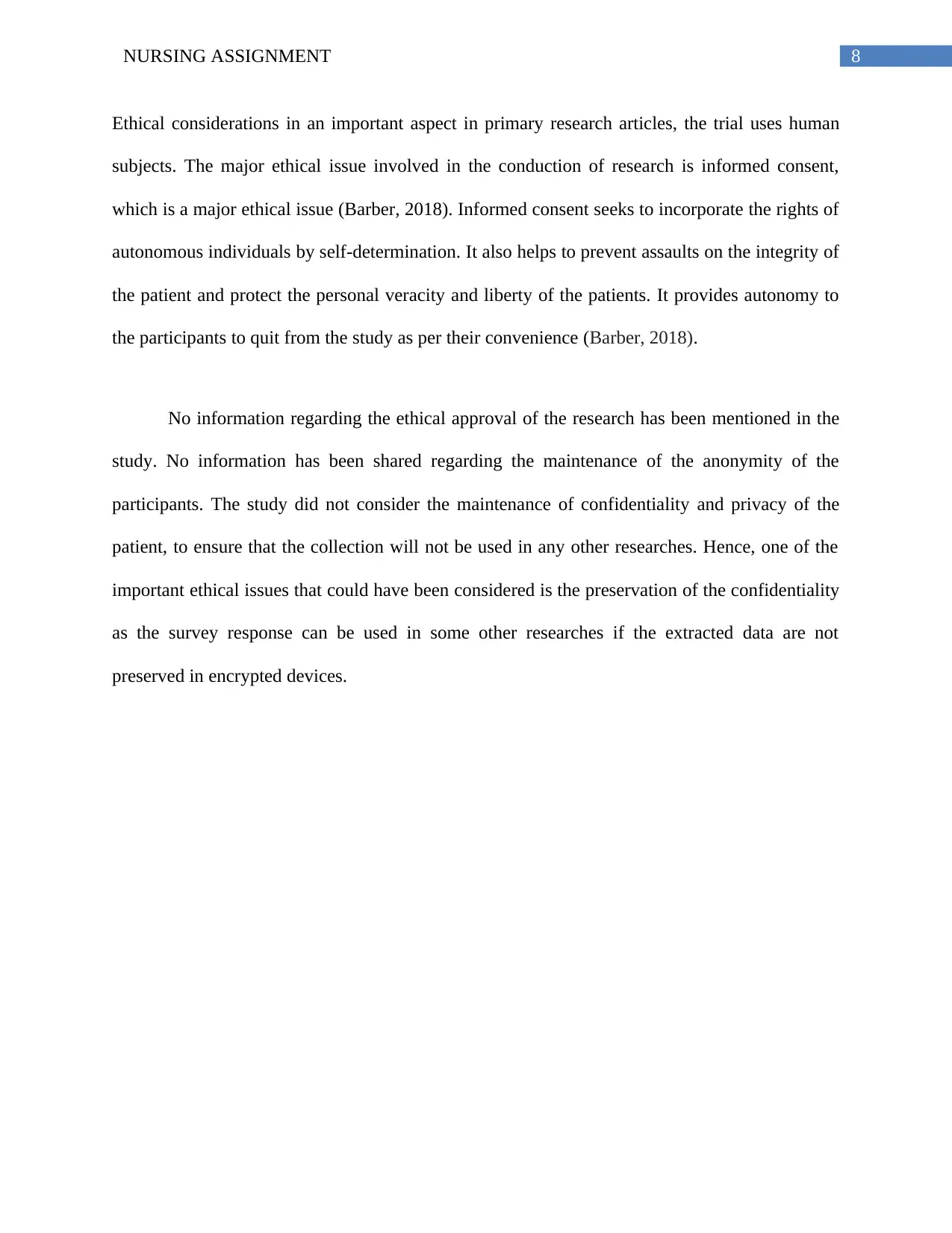
8NURSING ASSIGNMENT
Ethical considerations in an important aspect in primary research articles, the trial uses human
subjects. The major ethical issue involved in the conduction of research is informed consent,
which is a major ethical issue (Barber, 2018). Informed consent seeks to incorporate the rights of
autonomous individuals by self-determination. It also helps to prevent assaults on the integrity of
the patient and protect the personal veracity and liberty of the patients. It provides autonomy to
the participants to quit from the study as per their convenience (Barber, 2018).
No information regarding the ethical approval of the research has been mentioned in the
study. No information has been shared regarding the maintenance of the anonymity of the
participants. The study did not consider the maintenance of confidentiality and privacy of the
patient, to ensure that the collection will not be used in any other researches. Hence, one of the
important ethical issues that could have been considered is the preservation of the confidentiality
as the survey response can be used in some other researches if the extracted data are not
preserved in encrypted devices.
Ethical considerations in an important aspect in primary research articles, the trial uses human
subjects. The major ethical issue involved in the conduction of research is informed consent,
which is a major ethical issue (Barber, 2018). Informed consent seeks to incorporate the rights of
autonomous individuals by self-determination. It also helps to prevent assaults on the integrity of
the patient and protect the personal veracity and liberty of the patients. It provides autonomy to
the participants to quit from the study as per their convenience (Barber, 2018).
No information regarding the ethical approval of the research has been mentioned in the
study. No information has been shared regarding the maintenance of the anonymity of the
participants. The study did not consider the maintenance of confidentiality and privacy of the
patient, to ensure that the collection will not be used in any other researches. Hence, one of the
important ethical issues that could have been considered is the preservation of the confidentiality
as the survey response can be used in some other researches if the extracted data are not
preserved in encrypted devices.
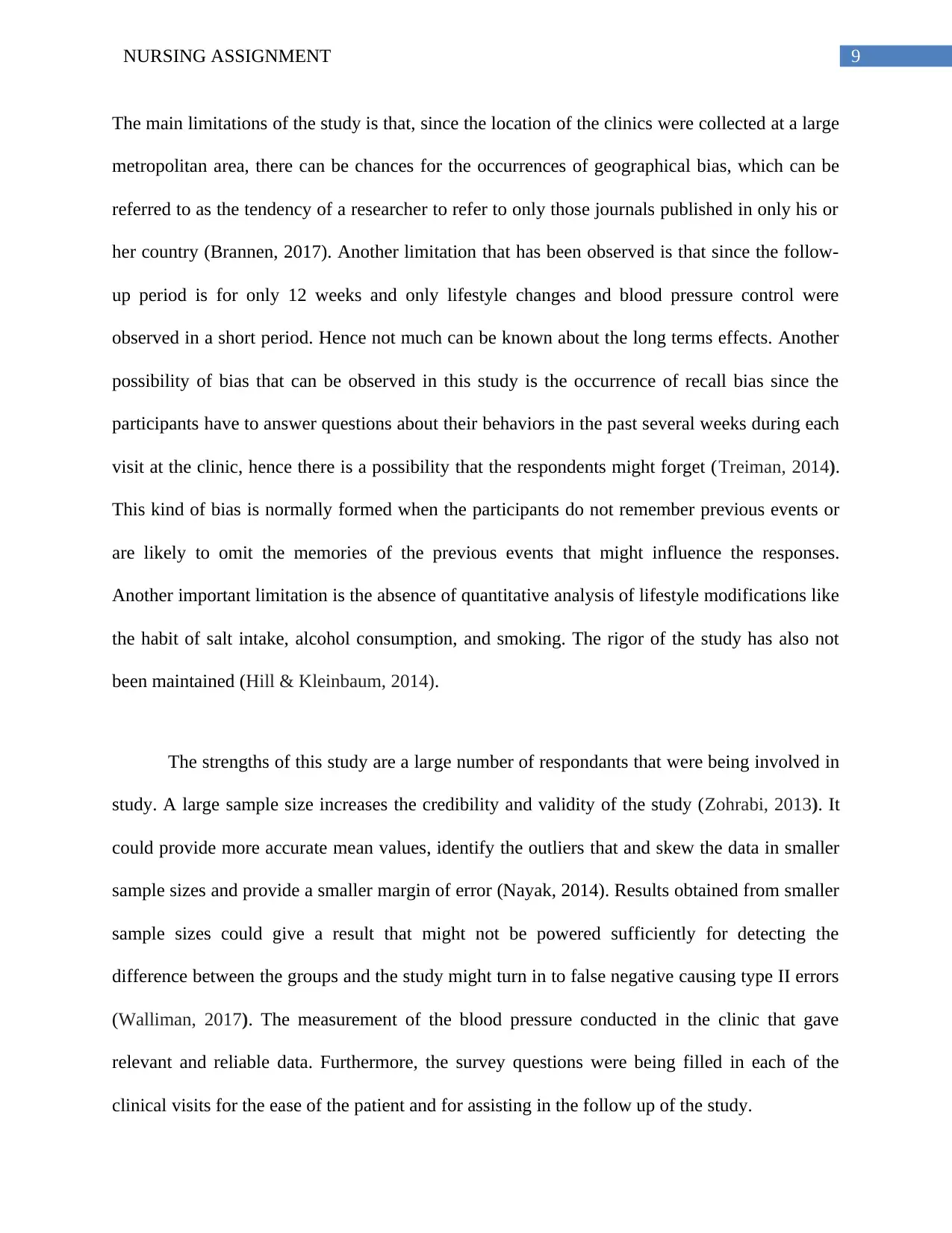
9NURSING ASSIGNMENT
The main limitations of the study is that, since the location of the clinics were collected at a large
metropolitan area, there can be chances for the occurrences of geographical bias, which can be
referred to as the tendency of a researcher to refer to only those journals published in only his or
her country (Brannen, 2017). Another limitation that has been observed is that since the follow-
up period is for only 12 weeks and only lifestyle changes and blood pressure control were
observed in a short period. Hence not much can be known about the long terms effects. Another
possibility of bias that can be observed in this study is the occurrence of recall bias since the
participants have to answer questions about their behaviors in the past several weeks during each
visit at the clinic, hence there is a possibility that the respondents might forget (Treiman, 2014).
This kind of bias is normally formed when the participants do not remember previous events or
are likely to omit the memories of the previous events that might influence the responses.
Another important limitation is the absence of quantitative analysis of lifestyle modifications like
the habit of salt intake, alcohol consumption, and smoking. The rigor of the study has also not
been maintained (Hill & Kleinbaum, 2014).
The strengths of this study are a large number of respondants that were being involved in
study. A large sample size increases the credibility and validity of the study (Zohrabi, 2013). It
could provide more accurate mean values, identify the outliers that and skew the data in smaller
sample sizes and provide a smaller margin of error (Nayak, 2014). Results obtained from smaller
sample sizes could give a result that might not be powered sufficiently for detecting the
difference between the groups and the study might turn in to false negative causing type II errors
(Walliman, 2017). The measurement of the blood pressure conducted in the clinic that gave
relevant and reliable data. Furthermore, the survey questions were being filled in each of the
clinical visits for the ease of the patient and for assisting in the follow up of the study.
The main limitations of the study is that, since the location of the clinics were collected at a large
metropolitan area, there can be chances for the occurrences of geographical bias, which can be
referred to as the tendency of a researcher to refer to only those journals published in only his or
her country (Brannen, 2017). Another limitation that has been observed is that since the follow-
up period is for only 12 weeks and only lifestyle changes and blood pressure control were
observed in a short period. Hence not much can be known about the long terms effects. Another
possibility of bias that can be observed in this study is the occurrence of recall bias since the
participants have to answer questions about their behaviors in the past several weeks during each
visit at the clinic, hence there is a possibility that the respondents might forget (Treiman, 2014).
This kind of bias is normally formed when the participants do not remember previous events or
are likely to omit the memories of the previous events that might influence the responses.
Another important limitation is the absence of quantitative analysis of lifestyle modifications like
the habit of salt intake, alcohol consumption, and smoking. The rigor of the study has also not
been maintained (Hill & Kleinbaum, 2014).
The strengths of this study are a large number of respondants that were being involved in
study. A large sample size increases the credibility and validity of the study (Zohrabi, 2013). It
could provide more accurate mean values, identify the outliers that and skew the data in smaller
sample sizes and provide a smaller margin of error (Nayak, 2014). Results obtained from smaller
sample sizes could give a result that might not be powered sufficiently for detecting the
difference between the groups and the study might turn in to false negative causing type II errors
(Walliman, 2017). The measurement of the blood pressure conducted in the clinic that gave
relevant and reliable data. Furthermore, the survey questions were being filled in each of the
clinical visits for the ease of the patient and for assisting in the follow up of the study.
Secure Best Marks with AI Grader
Need help grading? Try our AI Grader for instant feedback on your assignments.
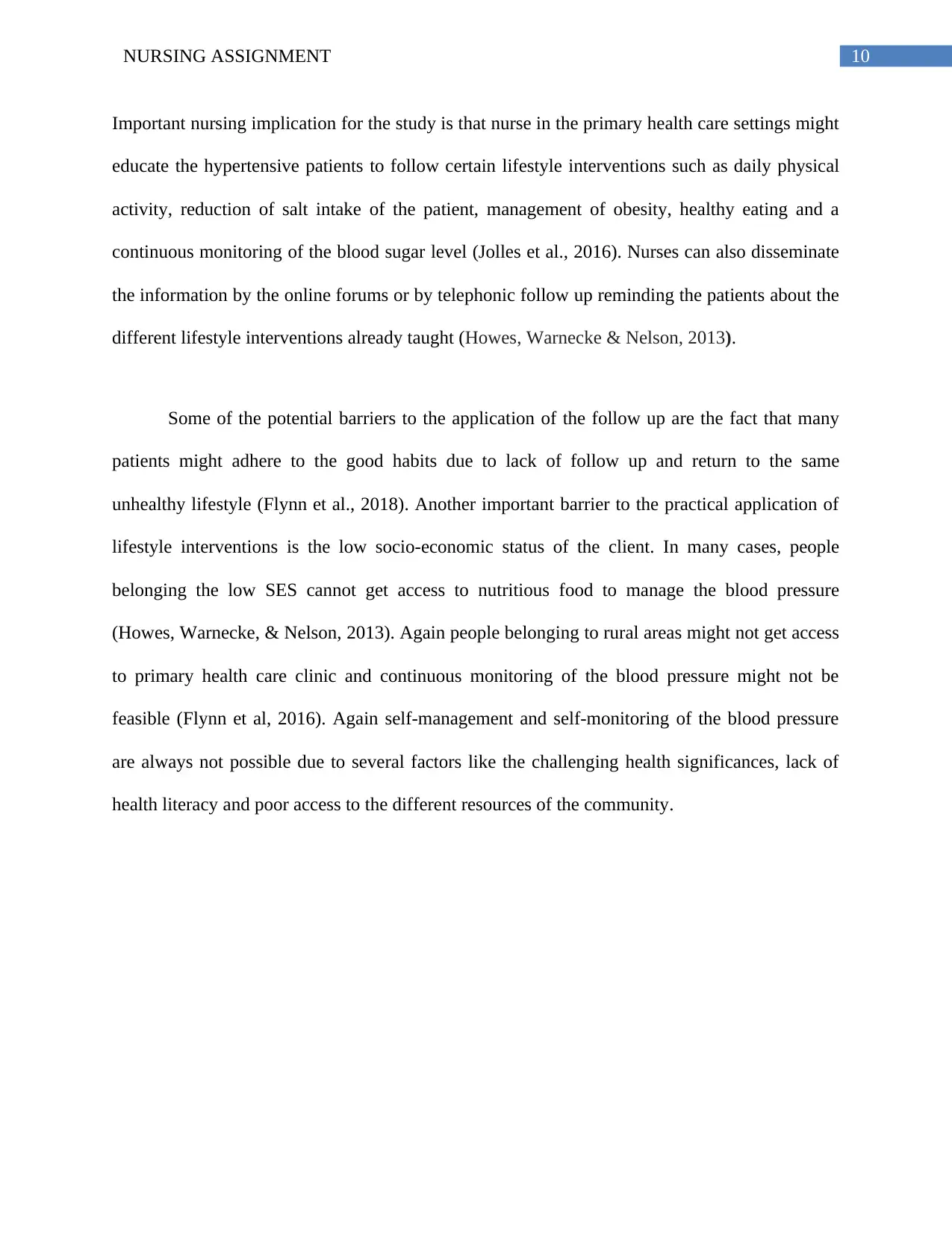
10NURSING ASSIGNMENT
Important nursing implication for the study is that nurse in the primary health care settings might
educate the hypertensive patients to follow certain lifestyle interventions such as daily physical
activity, reduction of salt intake of the patient, management of obesity, healthy eating and a
continuous monitoring of the blood sugar level (Jolles et al., 2016). Nurses can also disseminate
the information by the online forums or by telephonic follow up reminding the patients about the
different lifestyle interventions already taught (Howes, Warnecke & Nelson, 2013).
Some of the potential barriers to the application of the follow up are the fact that many
patients might adhere to the good habits due to lack of follow up and return to the same
unhealthy lifestyle (Flynn et al., 2018). Another important barrier to the practical application of
lifestyle interventions is the low socio-economic status of the client. In many cases, people
belonging the low SES cannot get access to nutritious food to manage the blood pressure
(Howes, Warnecke, & Nelson, 2013). Again people belonging to rural areas might not get access
to primary health care clinic and continuous monitoring of the blood pressure might not be
feasible (Flynn et al, 2016). Again self-management and self-monitoring of the blood pressure
are always not possible due to several factors like the challenging health significances, lack of
health literacy and poor access to the different resources of the community.
Important nursing implication for the study is that nurse in the primary health care settings might
educate the hypertensive patients to follow certain lifestyle interventions such as daily physical
activity, reduction of salt intake of the patient, management of obesity, healthy eating and a
continuous monitoring of the blood sugar level (Jolles et al., 2016). Nurses can also disseminate
the information by the online forums or by telephonic follow up reminding the patients about the
different lifestyle interventions already taught (Howes, Warnecke & Nelson, 2013).
Some of the potential barriers to the application of the follow up are the fact that many
patients might adhere to the good habits due to lack of follow up and return to the same
unhealthy lifestyle (Flynn et al., 2018). Another important barrier to the practical application of
lifestyle interventions is the low socio-economic status of the client. In many cases, people
belonging the low SES cannot get access to nutritious food to manage the blood pressure
(Howes, Warnecke, & Nelson, 2013). Again people belonging to rural areas might not get access
to primary health care clinic and continuous monitoring of the blood pressure might not be
feasible (Flynn et al, 2016). Again self-management and self-monitoring of the blood pressure
are always not possible due to several factors like the challenging health significances, lack of
health literacy and poor access to the different resources of the community.
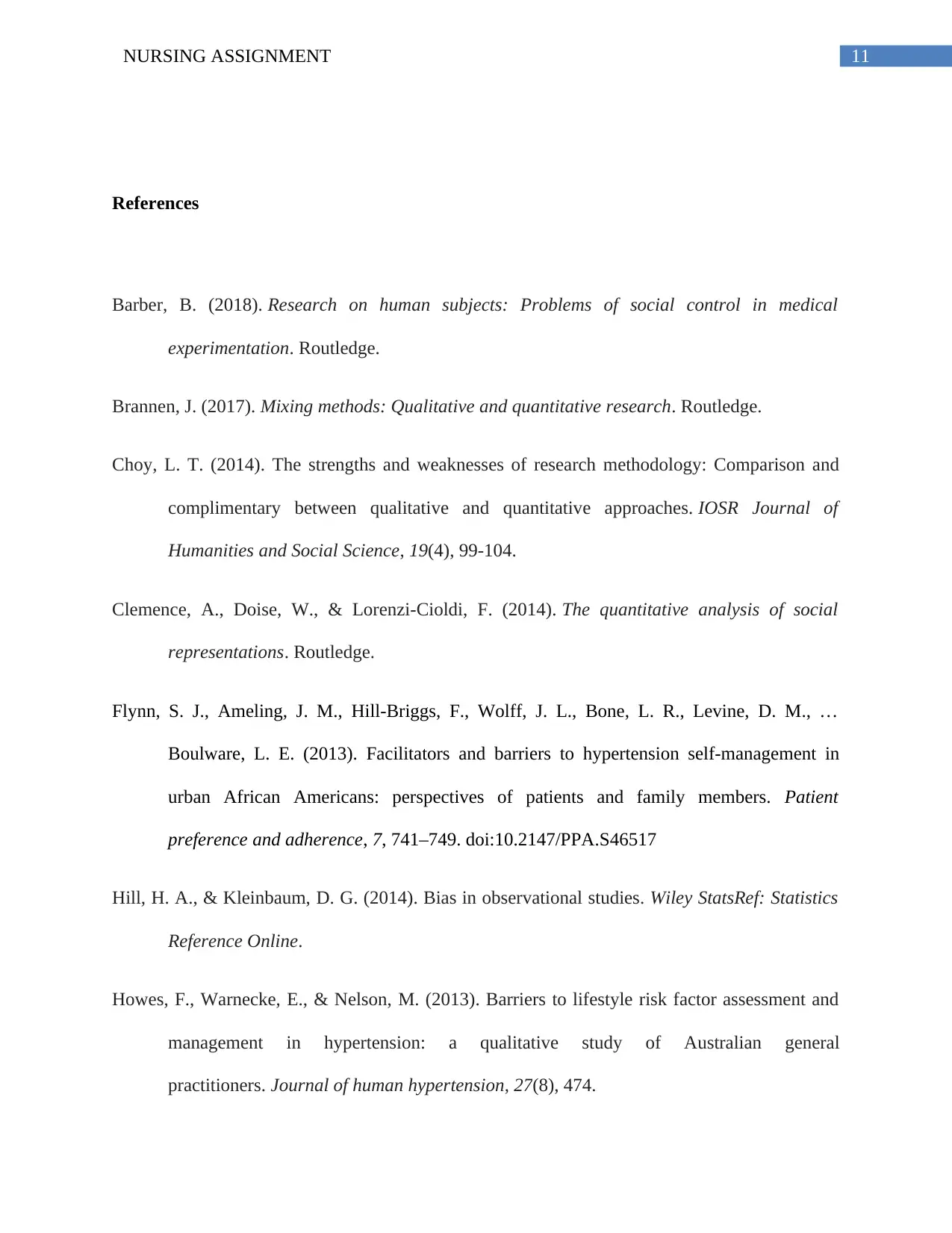
11NURSING ASSIGNMENT
References
Barber, B. (2018). Research on human subjects: Problems of social control in medical
experimentation. Routledge.
Brannen, J. (2017). Mixing methods: Qualitative and quantitative research. Routledge.
Choy, L. T. (2014). The strengths and weaknesses of research methodology: Comparison and
complimentary between qualitative and quantitative approaches. IOSR Journal of
Humanities and Social Science, 19(4), 99-104.
Clemence, A., Doise, W., & Lorenzi-Cioldi, F. (2014). The quantitative analysis of social
representations. Routledge.
Flynn, S. J., Ameling, J. M., Hill-Briggs, F., Wolff, J. L., Bone, L. R., Levine, D. M., …
Boulware, L. E. (2013). Facilitators and barriers to hypertension self-management in
urban African Americans: perspectives of patients and family members. Patient
preference and adherence, 7, 741–749. doi:10.2147/PPA.S46517
Hill, H. A., & Kleinbaum, D. G. (2014). Bias in observational studies. Wiley StatsRef: Statistics
Reference Online.
Howes, F., Warnecke, E., & Nelson, M. (2013). Barriers to lifestyle risk factor assessment and
management in hypertension: a qualitative study of Australian general
practitioners. Journal of human hypertension, 27(8), 474.
References
Barber, B. (2018). Research on human subjects: Problems of social control in medical
experimentation. Routledge.
Brannen, J. (2017). Mixing methods: Qualitative and quantitative research. Routledge.
Choy, L. T. (2014). The strengths and weaknesses of research methodology: Comparison and
complimentary between qualitative and quantitative approaches. IOSR Journal of
Humanities and Social Science, 19(4), 99-104.
Clemence, A., Doise, W., & Lorenzi-Cioldi, F. (2014). The quantitative analysis of social
representations. Routledge.
Flynn, S. J., Ameling, J. M., Hill-Briggs, F., Wolff, J. L., Bone, L. R., Levine, D. M., …
Boulware, L. E. (2013). Facilitators and barriers to hypertension self-management in
urban African Americans: perspectives of patients and family members. Patient
preference and adherence, 7, 741–749. doi:10.2147/PPA.S46517
Hill, H. A., & Kleinbaum, D. G. (2014). Bias in observational studies. Wiley StatsRef: Statistics
Reference Online.
Howes, F., Warnecke, E., & Nelson, M. (2013). Barriers to lifestyle risk factor assessment and
management in hypertension: a qualitative study of Australian general
practitioners. Journal of human hypertension, 27(8), 474.
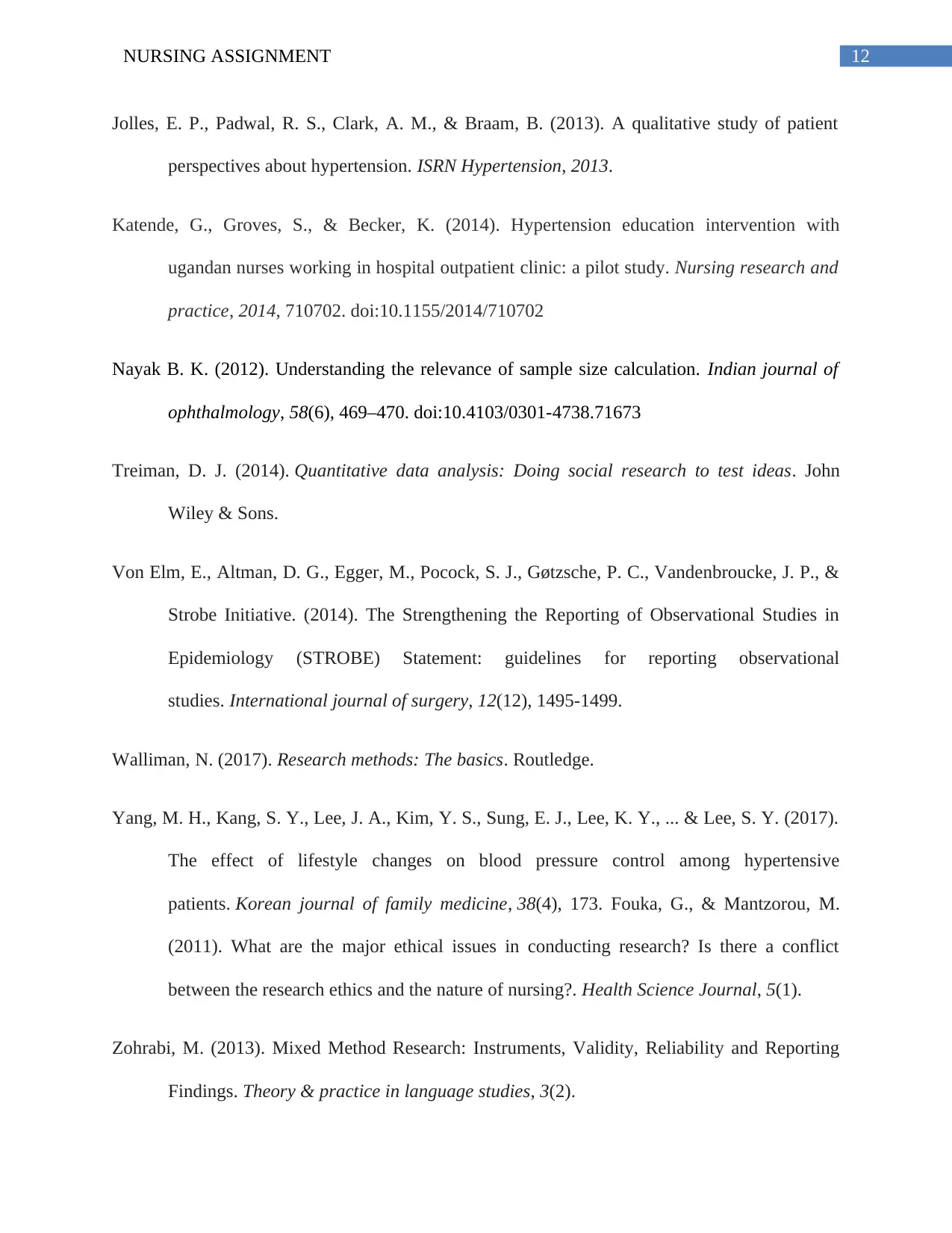
12NURSING ASSIGNMENT
Jolles, E. P., Padwal, R. S., Clark, A. M., & Braam, B. (2013). A qualitative study of patient
perspectives about hypertension. ISRN Hypertension, 2013.
Katende, G., Groves, S., & Becker, K. (2014). Hypertension education intervention with
ugandan nurses working in hospital outpatient clinic: a pilot study. Nursing research and
practice, 2014, 710702. doi:10.1155/2014/710702
Nayak B. K. (2012). Understanding the relevance of sample size calculation. Indian journal of
ophthalmology, 58(6), 469–470. doi:10.4103/0301-4738.71673
Treiman, D. J. (2014). Quantitative data analysis: Doing social research to test ideas. John
Wiley & Sons.
Von Elm, E., Altman, D. G., Egger, M., Pocock, S. J., Gøtzsche, P. C., Vandenbroucke, J. P., &
Strobe Initiative. (2014). The Strengthening the Reporting of Observational Studies in
Epidemiology (STROBE) Statement: guidelines for reporting observational
studies. International journal of surgery, 12(12), 1495-1499.
Walliman, N. (2017). Research methods: The basics. Routledge.
Yang, M. H., Kang, S. Y., Lee, J. A., Kim, Y. S., Sung, E. J., Lee, K. Y., ... & Lee, S. Y. (2017).
The effect of lifestyle changes on blood pressure control among hypertensive
patients. Korean journal of family medicine, 38(4), 173. Fouka, G., & Mantzorou, M.
(2011). What are the major ethical issues in conducting research? Is there a conflict
between the research ethics and the nature of nursing?. Health Science Journal, 5(1).
Zohrabi, M. (2013). Mixed Method Research: Instruments, Validity, Reliability and Reporting
Findings. Theory & practice in language studies, 3(2).
Jolles, E. P., Padwal, R. S., Clark, A. M., & Braam, B. (2013). A qualitative study of patient
perspectives about hypertension. ISRN Hypertension, 2013.
Katende, G., Groves, S., & Becker, K. (2014). Hypertension education intervention with
ugandan nurses working in hospital outpatient clinic: a pilot study. Nursing research and
practice, 2014, 710702. doi:10.1155/2014/710702
Nayak B. K. (2012). Understanding the relevance of sample size calculation. Indian journal of
ophthalmology, 58(6), 469–470. doi:10.4103/0301-4738.71673
Treiman, D. J. (2014). Quantitative data analysis: Doing social research to test ideas. John
Wiley & Sons.
Von Elm, E., Altman, D. G., Egger, M., Pocock, S. J., Gøtzsche, P. C., Vandenbroucke, J. P., &
Strobe Initiative. (2014). The Strengthening the Reporting of Observational Studies in
Epidemiology (STROBE) Statement: guidelines for reporting observational
studies. International journal of surgery, 12(12), 1495-1499.
Walliman, N. (2017). Research methods: The basics. Routledge.
Yang, M. H., Kang, S. Y., Lee, J. A., Kim, Y. S., Sung, E. J., Lee, K. Y., ... & Lee, S. Y. (2017).
The effect of lifestyle changes on blood pressure control among hypertensive
patients. Korean journal of family medicine, 38(4), 173. Fouka, G., & Mantzorou, M.
(2011). What are the major ethical issues in conducting research? Is there a conflict
between the research ethics and the nature of nursing?. Health Science Journal, 5(1).
Zohrabi, M. (2013). Mixed Method Research: Instruments, Validity, Reliability and Reporting
Findings. Theory & practice in language studies, 3(2).
1 out of 13
Related Documents
Your All-in-One AI-Powered Toolkit for Academic Success.
+13062052269
info@desklib.com
Available 24*7 on WhatsApp / Email
![[object Object]](/_next/static/media/star-bottom.7253800d.svg)
Unlock your academic potential
© 2024 | Zucol Services PVT LTD | All rights reserved.





